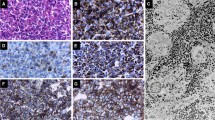Abstract
In reporting a case of GH-secreting hypophyseal adenoma associated with a carotid-ophthalmic aneurysm we discuss the possible relevance of an alteration of the type III to type I ratio in arterial wall collagen to the formation of intracranial aneurysms, known to be multifactorial in mechanism. The increased turnover of collagen and the type III collagen deficiency in the vessel wall present in acromegaly suggest that this secondary connective tissue change may have a role in the formation of intracranial aneurysms in patients with GH-secreting hypophyseal adenoma.
Sommario
Nel riportare un caso di adenoma dell'ipofisi ipersecernente ormone della crescita, associato a un aneurisma della carotide e dell'oftalmica, noi discutiamo la possibile importanza del rapporto tipo III-tipo I, nel collageno della parete arteriosa, agli effetti del formarsi degli aneurismi intracranici di cui conosciamo la genesi multifattoriale. L'aumentato turnover del collageno tipo III nella parete arteriosa, sempre presente nell'acromegalia, fa pensare che questo tipo di variante connettivale può avere un ruolo nella formazione di aneurismi intracranici in pazienti portatori di adenomi ipofisari ipersecernenti l'ormone della crescita.
Similar content being viewed by others
References
Acqui M., Ferrante L., Fraioli B., Cosentino F., Fortuna A., Mastronardi L.:Association between intracranial aneurysms and pituitary adenomas: aetiopathogenetic hypothesis. Neurochirurgia 30:177–181, 1987.
Andrews R.J., Spiegel P.K.:Intracranial aneurysms. Age, sex, blood pressure and multiplicity in an, unselected series of patients. J. Neurosurg. 51: 27–32, 1979.
Buddecke Eckhardt:Biochimica del collageno. Quaderni di Biochimica 22:5–51, 1981.
Byers P.H., Holbrook K.A., McGillivray B.:Clinical and ultrastructural heterogeneity of type IV Ehlers-Danlos syndrome. Hum. Genet. 47:141–150, 1979.
Chung E., Miller E.J.:Collagen polymorphism: characterization of molecules with the chain composition [α 1(III)3] in human tissues. Science 183: 1200–1201, 1974.
Dobrin P.B.:Mechanical properties of arteries. Physiol. Rev. 58:397–460, 1978.
Dobrin P.B., Baker W.H., Gley W.C.:Elastolytic and collagenolytic studies of arteries. Implications for mechanical properties of aneurysms. Arch. Aurg. 119:405–409, 1984.
Gay S., Miller E.J.:Collagen in the Physiology and Pathology of Connective Tissue. 46–62, Gustav Fischer Verlag, Stuttgart, 1978.
Handa H., Hashimoto N., Nagata I.:Saccular aneurysms in rats: a newly developed animal model of the disease. Stroke 14:857–866, 1983.
Handa J., Matsuda I., Handa H.:Association of brain tumor and intracranial aneurysms. Surg. Neurol. 4:25–29, 1976.
Ledet T.:Growth hormone stimulating the growth of arterial medial cell in vitro. Diabetes 25:1011–1017, 1976.
Miller E.J., Epstein E.H., Piez K.A.:Identification of three genetically distinct collagens by cyanogen bromide cleavage of insoluble human skin and cartilage collagen. Biochem. Biophys. Res. Commun. 42:1024–1028, 1971.
Neil-Dwyer G., Bartlett J.R., Nicholls A.C., Narcisi P., Pope F.M.:Collagen deficiency and ruptured cerebral aneurysms. A clinical and biochemical study. J. Neurosurg. 59:16–20, 1983.
Ostergaard J.R., Hog E.:Incidence of mutiple intracranial aneurysms. Influence of arterial hypertension and gender. J. Neurosurg. 63:49–55, 1985.
Ostergaard J.R., Oxlund H.:Collagen Type III deficiency in patients with rupture of intracranial saccular aneurysms. J. Neurosurg. 67:690–696, 1987.
Sacco F.L., Wolf P.A., Bharucha N.E.:Subarachnoid and intracerebral haemorrhage: natural history, prognosis, and precursive factor in the Framingham study. Neurology 34:847–854, 1984.
Schenk V.W.D., Solleveld H.:Multiple aneurysms in a case of acromegaly. Psichiatria, Neurologia, Neurochirurgia 71:309–317, 1978.
Sekhar L.N., Heros R.C.:Origin, growth and rupture of saccular aneurysms: a review. Neurosurgery 8:248–280, 1981.
Teodori U.:Trattato di patologia medica. Vol. 4: 3209, S.E.U., Roma, 1976.
Author information
Authors and Affiliations
Rights and permissions
About this article
Cite this article
Acqui, M., Ferrante, L., Matronardi, L. et al. Alteration of the collagen type III/type I ratio and intracranial saccular aneurysms in GH-secreting hypophyseal adenomas. Ital J Neuro Sci 9, 365–368 (1988). https://doi.org/10.1007/BF02334000
Issue Date:
DOI: https://doi.org/10.1007/BF02334000




